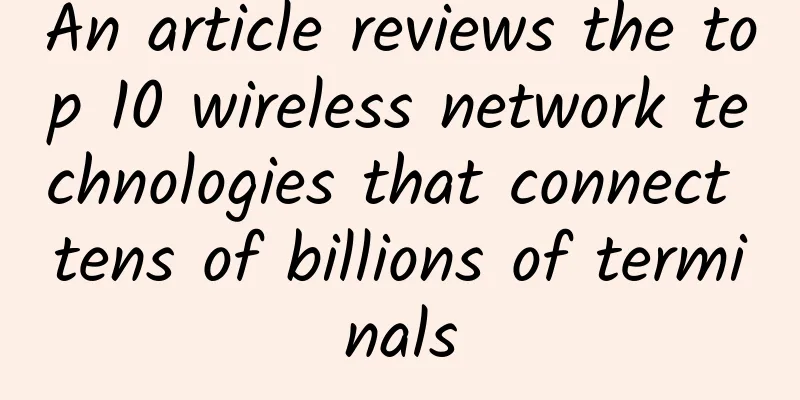An article reviews the top 10 wireless network technologies that connect tens of billions of terminals

|
With the development of the Internet industry, people's lives have become much more convenient. With Wi-Fi at home, 4G when going out, GPS for positioning, etc., it seems that the Internet has become another important part of life after food, clothing, housing and transportation, covering all aspects of life. However, in the era of the Internet of Everything, network connection technology needs to be further iterated.
The IoT architecture is generally divided into the perception layer, network layer, platform layer and application layer. The network layer is at the hub of the IoT ecosystem and plays a vital role in the connection of IoT devices. The ultimate goal of the IoT is still to serve people, so wireless network connection technology with higher portability has received more attention. In the Internet era, a large number of wireless network technologies have been developed, and wireless network connection technology has been better developed for the interconnection of all things. At present, wireless network connection technology can be divided into short-distance wireless connection technology and long-distance wireless connection technology according to the transmission distance. The following lists the five main technologies of each, including Bluetooth, Wi-Fi, NFC, ZigBee, UWB, GPRS, 5G, NB-IoT, LoRa, global satellite navigation system, etc. 1. Short-range wireless connection 1. Bluetooth Bluetooth is a wireless technology standard that enables short-range data exchange between fixed devices, mobile devices, and building personal area networks (using UHF radio waves in the ISM band of 2.4-2.485 GHz). Bluetooth can connect multiple devices, overcoming the problem of data synchronization. From audio transmission, image and text transmission, video transmission, to low-power IoT transmission, Bluetooth application scenarios are becoming more and more extensive. The first two generations of Bluetooth technology were both in the shaping stage of technology, developing Bluetooth technology into a reliable, secure and practical transmission and communication technology. With the advent of the 3G era, Bluetooth technology has also entered the third generation of high-speed transmission. The third generation of Bluetooth technology has a transmission rate of up to 24Mbps. The core is the use of AMP technology, which allows the Bluetooth protocol stack to dynamically select the correct radio frequency for any task. Just one year later, Bluetooth entered the 4.0 era. The fourth generation of Bluetooth technology is a Bluetooth comprehensive protocol specification, which increases the transmission distance of Bluetooth to more than 100 meters, has a faster response speed, and can complete the connection setup and start data transmission in as short as 3 milliseconds. It has also made great improvements in transmission rate, privacy protection and scalability, greatly improving the value of the technology. In 2016, with the rise of the Internet of Things, Bluetooth technology was updated to 5.0. Bluetooth 5.0 has faster and farther transmission capabilities in low-power mode, with a transmission rate twice that of the previous generation (up to 2Mbps), an effective transmission distance four times that of the previous generation (theoretically up to 300 meters), and a data packet capacity eight times that of the previous generation. At the same time, in order to better serve the Internet of Things, Bluetooth technology has developed a set of Mesh networks. Different from the "one-to-one" pairing of traditional Bluetooth connections, Mesh networks enable devices to achieve a "many-to-many" relationship. Therefore, Mesh networks can be distributed in manufacturing plants, office buildings, shopping centers, business parks and wider scenarios, providing more stable control solutions for lighting equipment, industrial automation equipment, security cameras, smoke detectors and environmental sensors. With the emergence of Bluetooth 5.0 technology and the maturity of Bluetooth Mesh technology, the threshold for long-distance and multi-device communication between devices has been greatly reduced, bringing greater imagination space for the future of IoT. 2. Wi-Fi Wi-Fi technology has become more and more a standard feature of our lives. Not only mobile phones and computers, but also more and more IoT devices support Wi-Fi. The Wi-Fi standard we currently use is an evolution of 802.11b, which was first released in 1997. The speed of 802.11b was only 2Mbps. 802.11g, which was proposed in 1999, increased the speed to 11Mbps. The current theoretical speed of 802.11ax is about 10Gbps. Wi-Fi has two networking structures: one-to-many (Infrastructure mode) and point-to-point (Ad-hoc mode, also called IBSS mode). The most commonly used Wi-Fi is a one-to-many structure. For example, the wireless router used in daily life is a router + AP (access point), which can access multiple devices. In addition, Wi-Fi can also realize a point-to-point structure. For example, two laptops can be directly connected using Wi-Fi without going through a wireless router. Traditional Wi-Fi uses the 2.4G frequency band. As more and more devices use the 2.4Ghz frequency band, the interference between them increases. Therefore, the fifth-generation Wi-Fi technology has developed a high-frequency band that runs above 5GHz. Theoretically, the 5G frequency band is faster than the 2.4G frequency band, but both have their own advantages and disadvantages. 2.4G has less attenuation when penetrating walls and a longer transmission distance, but it uses more devices and has greater interference; 5G has a more stable network speed and a higher rate, but it has greater attenuation when penetrating walls and has a shorter coverage distance. Standard WiFi (based on 802.11a/b/g/n/ac) is generally not an excellent technology for the Internet of Things, but due to the current widespread application of Wi-Fi technology, some IoT applications can take advantage of installed standard WiFi and put it into use in indoor or campus environments. WiFi HaLow based on 802.11ah is designed specifically for the Internet of Things, but it requires independent (compared to standard WiFi) infrastructure and dedicated clients, and is relatively complex. The currently proposed 802.11ax can already meet the use of most IoT devices, but whether 802.11ax will be adopted in the future Internet of Things will still depend on the cost of 802.11ax clients and the speed at which clients and APs enter the market. 3. NFC NFC, Near-field communication, is often translated into Chinese as near-field communication. NFC is a short-range high-frequency radio technology, a type of RFID technology, with an operating frequency of 13.56MHz and an effective working distance of less than 20cm. Its transmission speed is 106Kb/s, 212Kb/s or 424Kb/s. Data is read and exchanged through three business modes: card, card reader and point-to-point. NFC was first proposed in 2002 and has been widely used in bus cards, access cards, etc. The NFC technology, which had been unknown for a long time, has regained its vitality with the advent of the Internet of Things.
NFC technology is widely used in payment scenarios NFC technology has many advantages, such as good communication confidentiality, no power consumption, and low solution cost. In particular, NFC can connect instantly with a simple touch. After being integrated into IoT devices, the IoT system can collect data about user habits and usage patterns, and then provide it to the cloud or big data server for data analysis to improve the quality of user life. In the future, it will be more widely used in smart homes, payments, and smart cities. However, NFC's short communication distance and low communication rate are also its disadvantages, limiting NFC to only certain IoT applications. 4. ZigBee ZigBee is a wireless connection technology that can operate in three frequency bands: 2.4GHz (popular worldwide), 868MHz (popular in Europe) and 915 MHz (popular in the United States), with a maximum transmission rate of 250kbit/s, 20kbit/s and 40kbit/s respectively. Its transmission distance is within the range of 10-75m, but can be further increased. In terms of networking performance, ZigBee can be constructed as a star network or a point-to-point peer-to-peer network. In each ZigBee wireless network, the connection address code is divided into a 16b short address or a 64b long address, and the number of devices that can be accommodated is 216 and 264 respectively, with a large network capacity. In wireless communication technology, the CSMA-CA method is adopted to effectively avoid conflicts between radio carriers. In addition, a complete response communication protocol is established to ensure the reliability of transmitted data. In addition, ZigBee devices have the characteristics of low power consumption, low data transmission rate, high compatibility and low implementation cost. It has now developed to version 3.0 and is widely used in smart homes, smart medical care, smart buildings and energy. 5. Ultra-Wideband (UWB) Ultra-wideband technology is a new wireless communication technology that has emerged in recent years and is very different from traditional communication technology. It does not need to use the carrier in the traditional communication system, but transmits data by sending and receiving extremely narrow pulses with a length of nanoseconds or microseconds, thus having a bandwidth of 3.1 to 10.6 GHz. By transmitting extremely low-power signals over a wider spectrum, UWB can achieve data transmission rates of hundreds of Mbit/s to several Gbit/s within a range of about 10 meters. In addition to high transmission rates, UWB technology also has the advantages of low transmission power, strong penetration, and strong anti-interference performance. It can obtain more accurate results in the field of indoor positioning and is widely used in small-scale, high-resolution radar and image systems that can penetrate walls, ground and bodies. In addition, this new technology is suitable for LANs or PANs that require very high rates (greater than 100 Mb/s). 2. Long-distance wireless connection 1. GPRS GPRS is the abbreviation of General Packet Radio Service, which is a long-distance communication technology between terminals and communication base stations. GPRS can be said to be the continuation of GSM. It transmits data in packets and does not monopolize channels, so it can make better use of idle channel resources on GSM. The transmission rate of GPRS can reach 56~114Kbps. By using this data service, users can connect to the communication base station of the telecom operator, and then connect to the Internet to obtain Internet information. GPRS has the characteristics of making full use of the existing network, high transmission rate, reasonable tariff, high resource utilization, and always online. It is currently widely used in almost all outdoor mobile Internet of Things application scenarios such as environmental monitoring, automatic meter reading, power company transmission line detection, Internet of Vehicles, engineering construction quality supervision, smart agriculture, etc. 2. 5G In recent years, the development of 5G has always attracted attention. Huawei and other companies have made rapid progress in 5G development. It is expected that 5G will soon be present in all aspects of our lives. In the definition of 5G by the ITU Radiocommunication Group in 2015, the massively connected IoT service mMTC was listed as one of the three major application scenarios of 5G in the future. Compared with 4G, 5G has all-round improvements. 5G has higher bandwidth, lower latency, and more massive access capabilities, which can meet many needs in the field of IoT. The peak theoretical transmission speed of 5G can reach tens of Gb per second, which is 100 times faster than 4G. It can strengthen the connection between things and expand the application of mobile networks in the IoT in various vertical industries. As many people have said, 5G is for the Internet of Things. The speed and access capabilities of 5G networks are more powerful, and they can truly connect everything. Not only smart cities, but also artificial intelligence, autonomous driving, remote surgery and other aspects will become smarter because of 5G, and the Internet of Everything will also be popularized because of 5G. 3. NB-IoT NB-IoT refers to Narrow Band-Internet of Things technology, an emerging technology focusing on the low power consumption and wide coverage (LPWAN) Internet of Things (IoT) market, and has been widely used around the world. NB-IoT is built on cellular networks, uses licensed frequency bands, consumes only about 180KHz of bandwidth, and can be deployed in three ways: in-band, guard band, or independent carrier, reducing deployment costs and achieving smooth upgrades. NB-IoT has the characteristics of wide coverage, multiple connections, fast speed, low cost, low power consumption, and excellent architecture. Generally speaking, an NB-IOT base station can cover a range of 10km, which has a 20dB gain improvement compared to a GPRS base station, and can cover underground garages, basements, underground pipelines and other places where signals are difficult to reach. At present, NB-IoT has been widely used in remote meter reading, asset tracking, smart parking, smart agriculture and other fields, and has attracted more and more attention from the market. However, NB-IoT still has many shortcomings. The deployment frequency of NB-IoT must be authorized and operators must spend money to deploy it. In addition, the module cost is still high. Although the module price has been reduced to less than 20 yuan recently, it is still a long way from the low cost required for the explosive growth of the market. 4. LoRa LoRa refers to Long Range Radio technology. Under the same power consumption conditions, LoRa is 3-5 times the traditional wireless radio communication distance, achieving the unity of low power consumption and long distance. LoRa mainly operates in the global free frequency bands (i.e. unlicensed frequency bands), including 433, 868, 915 MHz, etc. It has the advantages of low power consumption, high sensitivity, and large capacity. Compared with NB-IoT, the comprehensive cost of LoRa (gateway, module, operating cost, etc.) is not high, and the flexible characteristics of LoRa can make it easier for enterprises to integrate systems based on LoRa connection technology and provide users with complete solutions, which not only better meets user needs, but also brings more commercial added value to LoRa enterprises. Not only in the metering field, LoRa has also achieved breakthrough development in non-metering fields, including many successful application cases in smart buildings, smart cities, street lights, agriculture, etc. At present, more than 10 million LoRa nodes are deployed in China each year, and city-level LoRa networks are covered in Beijing, Shenzhen, Guangzhou, Hangzhou and other cities. 5. Global Navigation Satellite System There are four major satellite navigation systems in the world: China's Beidou Navigation System, the US GPS, Russia's GLONASS system and the European Union's Galileo Satellite Navigation System. Among them, the first to be put into use and the most successful commercialization is the US GPS. After years of unremitting development, my country's Beidou system has also reached an advanced level. Take Beidou as an example. With the completion of the networking of Beidou satellites and the construction of the ground Beidou network, the Beidou navigation system can improve positioning accuracy to centimeters or even millimeters.
The Beidou system has the characteristics of low latency, low power consumption, low cost and wide coverage. It is of great significance in the era of the Internet of Things. It has been widely used in security, smart cities, smart parking, smart homes, logistics and transportation, government law enforcement, port command and dispatch, railway intelligent inspection, smart meters and other fields. |
<<: Ruijie Smart Town E-Day Tour
>>: WiFi stuck, maybe it's the wireless network card
Recommend
What happens when you enter a URL in your browser (Part 4): Network packets are transmitted in a LAN - how routers and switches forward packets
In the previous section, we introduced how networ...
Operators' mid-term performance is impressive, and 5G development has entered a critical moment
2021 is a big year for China's 5G development...
Things about WKWebView on iOS
[[413463]] Background Students who are familiar w...
Ruijie Networks kicks off its "Renewal Action" with the 2023 National Partner Conference
On April 7, the Ruijie Networks 2023 National Par...
Predictions from global telecom industry experts for 2024
Predictions from global telecom industry experts ...
DiyVM: Hong Kong CN2/US CN2 unlimited traffic VPS monthly payment starts from 50 yuan, Hong Kong server monthly payment starts from 499 yuan
Next, let me share some information about DiyVM, ...
From comfort zone to challenge zone, operators enter a period of deep adjustment
Data released by the Ministry of Industry and Inf...
V2X communication: A new era of cooperation between vehicles and infrastructure
V2X communication, or vehicle-to-everything commu...
What should I do if I forget my Wi-Fi password? You can retrieve the password through Windows
With the development of technology, WiFi plays an...
AT&T suspends 3G network and offers free entry-level 4G LTE smartphones
According to Zhongguancun Online, US telecommunic...
5G meets WiFi on a narrow road, walking hand in hand in a friendly way
Recently, both domestic and foreign operators hav...
China's IPv6 highway has been fully completed, and the number of active users has reached 551 million
At present, the world is experiencing a profound ...
Survey: Germany more dependent on Huawei 5G equipment than before
Germany is even more reliant on Huawei for its 5G...
Private operators, which were not optimistic in the past, are starting to make progress in the 5G era
Why are the three major operators called the thre...
Probably the most comprehensive inventory of well-known 404 pages at home and abroad
There is a legend circulating on the Internet abo...








![[Black Friday] CloudCone: Los Angeles VPS from $16.79/year, Premium SC2 from $32.94/year](/upload/images/67cabff9214b9.webp)
